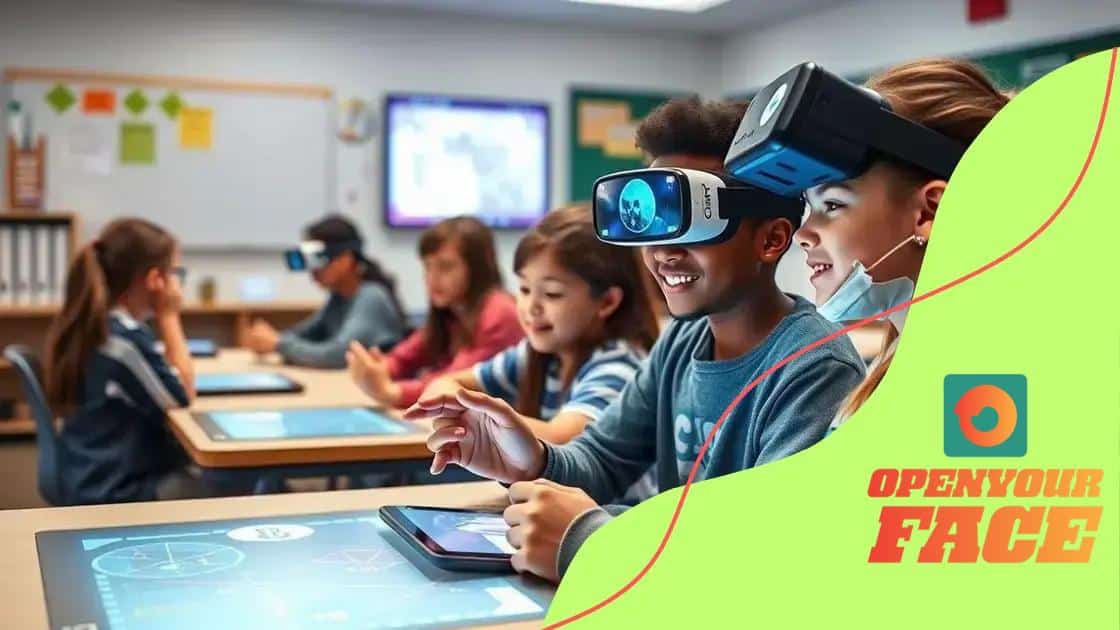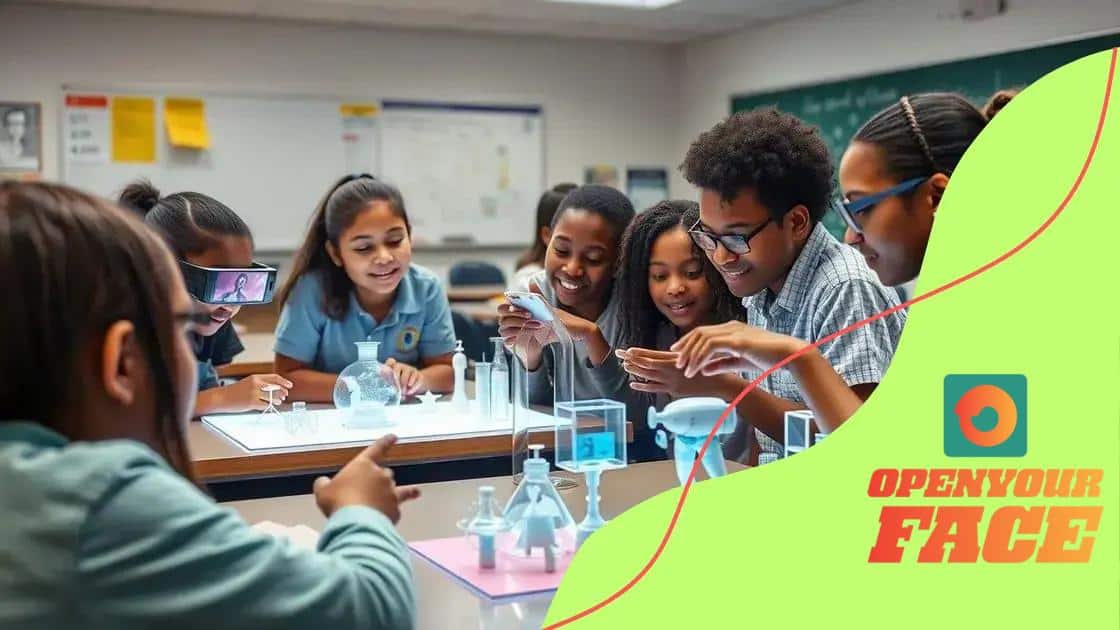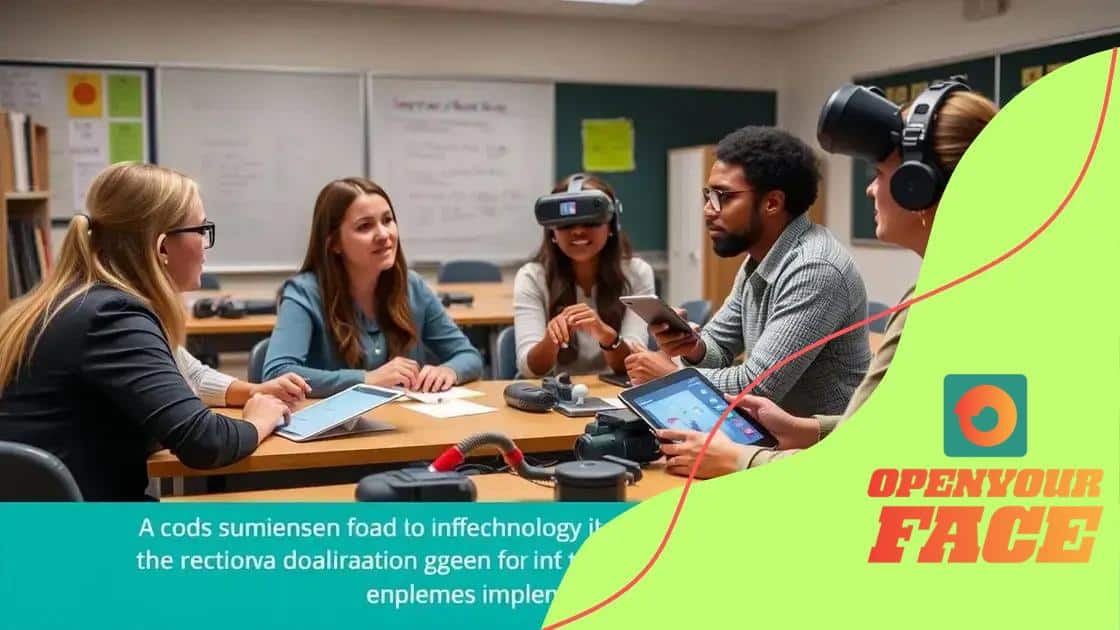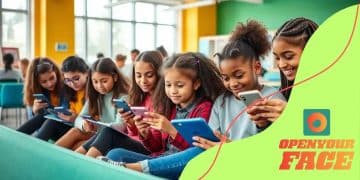How augmented reality is enhancing STEM education

Augmented reality is enhancing STEM education by providing immersive, interactive experiences that increase engagement, improve understanding of complex concepts, and enable personalized learning tailored to individual student needs.
How augmented reality is enhancing STEM education is an exciting topic that merges technology with learning. Imagine students exploring complex science concepts through interactive, immersive experiences. This article delves into how AR is changing the educational landscape.
Understanding augmented reality in education
Understanding augmented reality in education is crucial for modern teaching methods. Augmented reality (AR) provides an interactive way for students to engage with their studies. By combining digital elements with the real world, AR can make learning more exciting and effective.
What is Augmented Reality?
Augmented reality refers to technology that overlays digital information onto the physical world. This can include visuals, sounds, and other sensory enhancements, providing immersive experiences that traditional learning methods lack.
Benefits of AR in Education
- Improved engagement among students.
- Enhanced understanding of complex subjects.
- Opportunities for hands-on learning experiences.
- Increased motivation and interest in STEM fields.
When students explore subjects through dynamic visuals and interactions, they grasp concepts more deeply. For instance, they can visualize chemical reactions or see the inner workings of a machine in a way that textbooks can’t offer.
Furthermore, AR can tailor the learning experience to meet individual needs. By allowing students to explore topics at their own pace, they can revisit challenging areas until they achieve understanding. This personalized approach helps students feel more confident and capable.
Real-World Applications
Schools are beginning to implement AR in various subjects. For example, science classes can use AR apps to illustrate anatomical structures. History lessons might come alive with 3D models of ancient artifacts or historical events. These tools also allow for collaborative projects, where students can work in teams to explore shared AR environments.
On the technology front, AR is becoming more accessible. Devices like tablets and smartphones are equipped with AR capabilities, making it easier for schools to integrate this technology into their classrooms. With simple apps designed for education, teachers can quickly adopt AR into their lesson plans.
As AR technology continues to grow, it holds the potential to transform education significantly. Schools that embrace this innovation may set their students up for better success in the future by fostering a deeper connection with their studies.
Key benefits of AR for STEM learning

The key benefits of augmented reality (AR) for STEM learning are transforming education in exciting ways. By creating immersive experiences, AR helps students engage with complex topics. This technology sparks curiosity and encourages deeper understanding.
Enhanced Engagement
One of the main advantages of AR is its ability to enhance student engagement. Traditional learning methods can sometimes be dull, but AR offers interactive experiences that capture students’ attention.
- AR makes learning fun and interactive.
- Students can visualize difficult concepts.
- Hands-on experiences foster active participation.
When students interact with 3D models, they are more likely to retain information. For example, rather than just reading about the solar system, a student could explore it through AR, seeing the planets in relation to one another.
Improved Understanding
AR also improves understanding by providing visual and tactile experiences. With AR, students can manipulate objects in a virtual space. This leads to better comprehension of abstract ideas. For instance, a student can see the molecular structure of a substance and interact with it, allowing them to grasp how it behaves in different situations.
Furthermore, AR can break down complex ideas into simpler visual representations. For example, students learning about electricity can see how current flows in a circuit with live demonstrations through AR apps.
Collaboration Opportunities
Another key benefit of AR is that it encourages collaboration among students. By working together in augmented environments, they can solve problems and complete projects as a team. This collaboration helps develop essential skills such as teamwork and communication.
- Students learn from each other.
- Group projects using AR foster creative thinking.
- Collaborative problem-solving improves critical thinking skills.
As students collaborate, they share ideas and insights, enhancing their overall learning experience. By integrating technology into group activities, AR creates a sense of community in classrooms.
Overall, the key benefits of AR for STEM learning are undeniable. As schools continue to adopt this technology, students will be better prepared for the future.
Practical applications of AR in classrooms
Practical applications of augmented reality (AR) in classrooms are rapidly changing the way students learn. AR promotes interactive education, making complex subjects more accessible. Teachers can use AR tools to enhance traditional lessons with engaging, hands-on experiences.
Interactive Science Experiments
One effective use of AR in classrooms is for science experiments. Students can conduct virtual experiments to see real-world reactions without any risks. For example, they could create chemical reactions in a safe environment where they can visualize the process.
- Simulate chemical reactions safely.
- Explore anatomy through 3D models.
- Observe ecological systems in virtual environments.
Such interactive experiments allow students to understand scientific concepts better, as they can visualize processes and outcomes realistically.
History Lessons with AR
Another application is in history education. AR brings historical events to life by allowing students to experience them in a more immersive way. By using AR apps, students can view 3D recreations of historical artifacts or explore significant locations remotely.
- Walk through ancient ruins virtually.
- Interact with historical figures in simulations.
- Analyze famous artworks in 3D.
This vivid interaction helps students connect emotionally with the subject, enhancing their learning experience.
Mathematics and Geometry Visualizations
AR is also beneficial in mathematics, especially geometry. Students can manipulate 3D shapes and figures, making abstract concepts more tangible. During lessons, they can rotate shapes and see cross-sections, deepening their understanding.
With AR, students learn to visualize mathematical problems, making it easier to grasp difficult concepts. They can experiment with shapes, angles, and dimensions at their own pace, fostering independent learning.
Moreover, AR can support personalized learning experiences, allowing students to progress through the material as they become comfortable with different topics. As technologies advance, more options for AR applications in education will likely emerge, empowering educators to create dynamic learning environments.
Challenges in implementing AR technology

Challenges in implementing augmented reality (AR) technology in education can hinder its full potential. While AR has many benefits, some barriers must be addressed to make it effective in classrooms. These challenges range from technical issues to teacher training.
Technical Limitations
One major challenge involves the technical limitations of AR technology itself. Not all schools have access to the necessary devices, such as tablets or AR glasses. Additionally, the quality of AR applications can vary significantly.
- Some AR apps may not work effectively on all devices.
- Technical glitches can disrupt learning experiences.
- High costs can limit access to advanced technologies.
These technical issues can prevent schools from utilizing AR fully, making it essential for educators to find reliable solutions that are accessible and affordable.
Teacher Training and Support
Another significant barrier is the need for adequate training for teachers. Implementing AR technology effectively requires educators to understand how to use these tools. Many teachers may not feel confident in their ability to incorporate AR into their lesson plans.
This lack of training can lead to underutilization of AR technology, as teachers may be unsure how to integrate it alongside traditional teaching methods. It’s crucial for schools to provide professional development opportunities for teachers.
Curriculum Alignment
Additionally, integrating AR into existing curricula can be a challenge. Teachers must ensure that AR experiences align with learning objectives and standards. Creating lessons that effectively incorporate AR takes time and effort.
Some teachers may struggle to find appropriate AR content that fits within their specific subjects. The lack of readily available resources can hinder the potential of AR in education.
Despite these challenges, schools that address these issues can harness the power of AR technology. By investing in training and resources, educators can create engaging learning environments that benefit students.
Future trends in augmented reality and education
Future trends in augmented reality (AR) and education promise to reshape how students learn. As technology advances, AR is becoming more immersive and accessible, leading to exciting possibilities in classrooms around the world.
Increased Accessibility
One trend is the development of more accessible AR tools. With affordable devices becoming widely available, more schools can integrate AR into their curricula. Mobile devices like smartphones and tablets are already capable of supporting AR applications, making this technology available to a larger number of students.
- Lower costs for AR software and devices.
- Greater internet accessibility in schools.
- Enhanced user-friendly interfaces for AR applications.
This accessibility allows educators to adopt innovative teaching methods that can benefit diverse learners.
Enhanced Interactivity
As AR technology evolves, interactivity will also improve. Future AR applications are likely to provide more engaging experiences, allowing students to explore complex subjects hands-on. Imagine virtual field trips where students can interact with environments, exploring everything from the ocean floor to outer space—all from their classrooms.
These interactive experiences can increase motivation and interest in learning, making students more eager to participate and collaborate. Teachers will be able to create unique lesson plans that cater to different learning styles.
Personalized Learning
Another significant trend is personalized learning through AR. In the future, AR will enable tailored educational experiences for individual students. By analyzing a student’s progress, AR applications can adjust difficulty levels, content types, and learning methods.
This adaptive technology will help address each student’s unique needs and abilities, ensuring that no one falls behind. Teachers will have better tools to support students at all levels.
Collaboration between Educators and Tech Developers
The future will also see increased collaboration between educators and technology developers. Schools and tech companies will work together to create effective AR solutions tailored to educational goals. This partnership will help ensure that AR tools meet classroom needs, enhancing the overall learning experience.
As these trends continue to develop, AR has immense potential to revolutionize the education landscape, making learning more interactive, personalized, and engaging for all students.
FAQ – Frequently Asked Questions about Augmented Reality in Education
What are the main benefits of using augmented reality in classrooms?
The main benefits include increased engagement, improved understanding of complex subjects, and personalized learning experiences that cater to individual student needs.
What challenges do schools face when implementing AR technology?
Schools may encounter challenges such as technical limitations, the need for teacher training, and ensuring that AR content aligns with curriculum standards.
How can augmented reality enhance science education?
AR can bring science to life by allowing students to conduct virtual experiments and visualize difficult concepts, making learning both interactive and safe.
What future trends can we expect in augmented reality and education?
Future trends include increased accessibility to AR tools, enhanced interactivity in learning experiences, and greater personalization tailored to each student’s unique learning path.






